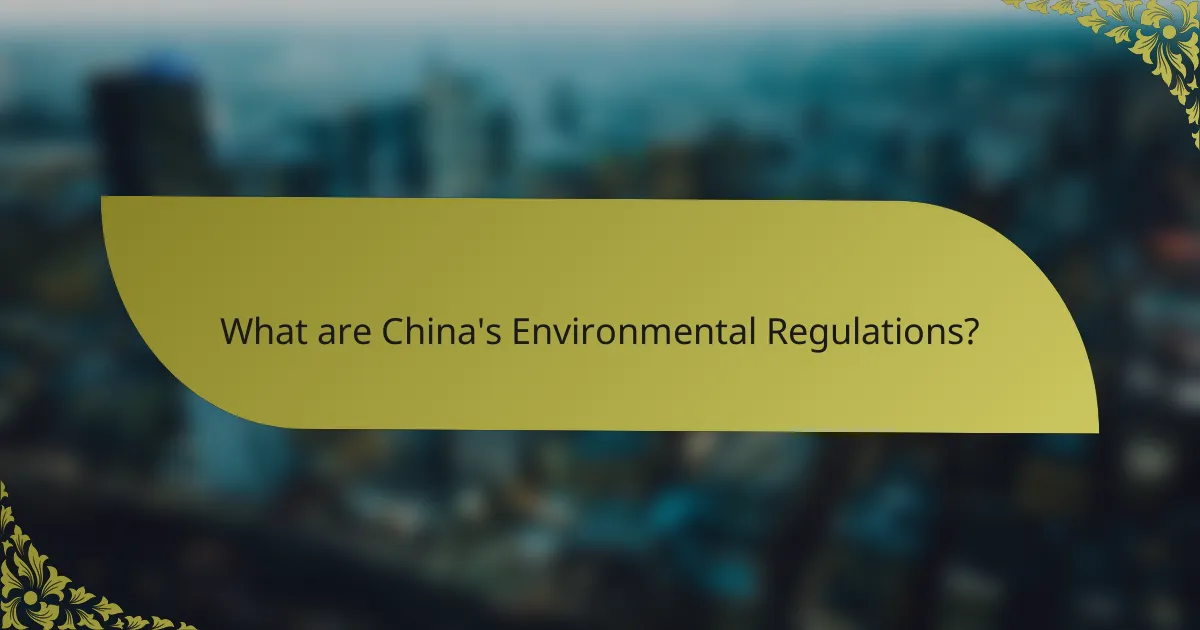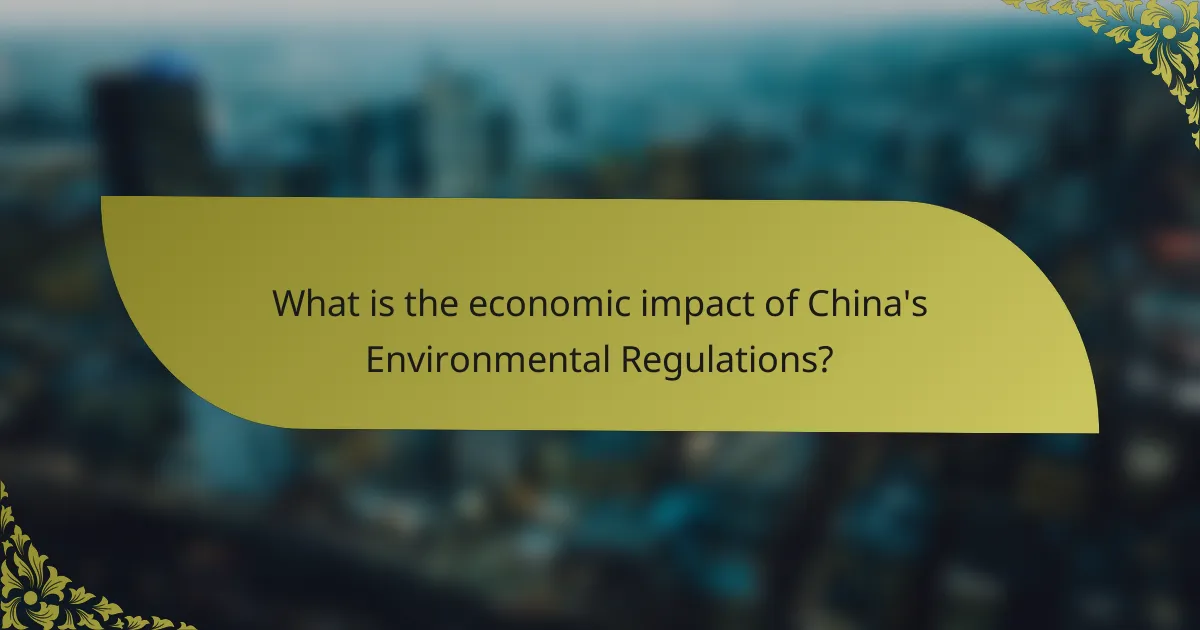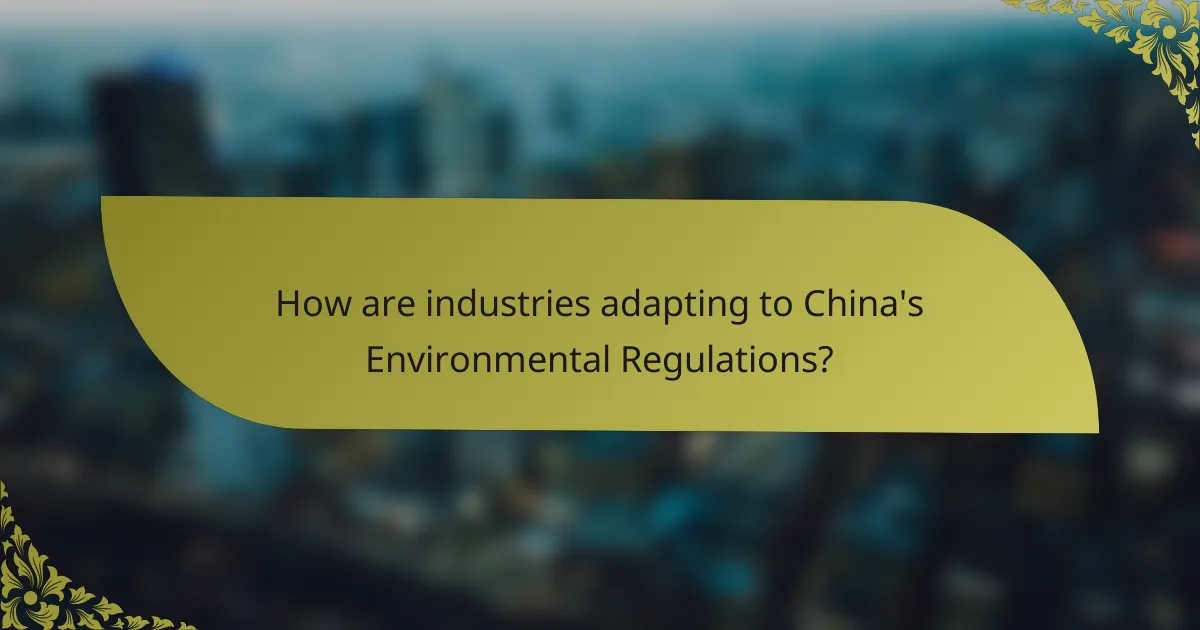China’s environmental regulations are a comprehensive framework of laws and policies designed to safeguard the environment and foster sustainable development. Key components include the Environmental Protection Law of 2014, which enforces stricter penalties for violations, and the Air Pollution Prevention and Control Action Plan, aimed at improving air quality. These regulations significantly influence the economy, leading to increased operational costs for industries while also driving innovation in green technologies. Companies are adapting by investing in cleaner practices and renewable energy, which has resulted in notable reductions in industrial pollution. Overall, these regulations play a crucial role in achieving China’s sustainability goals and aligning with global environmental standards.

What are China’s Environmental Regulations?
China’s environmental regulations are a set of laws and policies aimed at protecting the environment and promoting sustainable development. These regulations cover air and water quality, waste management, and biodiversity conservation. The Environmental Protection Law of 2014 is a key framework, emphasizing stricter penalties for violations. Additionally, China has implemented the Air Pollution Prevention and Control Action Plan to address severe air quality issues. The government also promotes renewable energy through incentives and regulatory support. In recent years, China has increased its focus on green development as part of its broader economic strategy. These regulations are vital for achieving China’s sustainability goals and aligning with global environmental standards.
How do these regulations aim to promote sustainability?
These regulations promote sustainability by enforcing stricter environmental standards. They require industries to reduce emissions and waste. Compliance leads to cleaner air and water. Regulations also incentivize the use of renewable energy sources. For instance, the Renewable Energy Law encourages solar and wind energy investments. Additionally, regulations support sustainable resource management practices. They aim to protect biodiversity and ecosystems. Overall, these measures drive a transition towards a low-carbon economy.
What specific sustainability goals are outlined in these regulations?
The specific sustainability goals outlined in these regulations include reducing carbon emissions, promoting renewable energy, and enhancing resource efficiency. These goals aim to address climate change and improve environmental quality. Regulations target a significant reduction in greenhouse gas emissions by 2030. They encourage the use of solar, wind, and other renewable energy sources. Additionally, the regulations promote energy conservation and waste reduction in industries. They also aim to protect biodiversity and improve air and water quality. These sustainability goals align with China’s commitment to international climate agreements.
How do these goals align with global environmental standards?
China’s sustainability goals align with global environmental standards by committing to reduce carbon emissions and enhance energy efficiency. These goals reflect the objectives set forth in international agreements, such as the Paris Agreement. For instance, China aims to peak carbon emissions before 2030 and achieve carbon neutrality by 2060. This commitment is consistent with the global target to limit temperature rise to 1.5 degrees Celsius. Furthermore, China’s focus on renewable energy development supports the global transition towards sustainable energy sources. The country is investing heavily in solar and wind energy, positioning itself as a leader in green technology. These actions demonstrate China’s alignment with global efforts to combat climate change and promote sustainable development.
What is the historical context of these regulations?
China’s environmental regulations have evolved significantly since the late 20th century. The initial framework emerged in the 1970s, influenced by rapid industrialization and environmental degradation. In 1998, the State Environmental Protection Administration was established, marking a formal commitment to environmental governance. The 2002 Environmental Protection Law introduced stricter compliance measures for industries. By 2015, the revised law included harsher penalties for violations, reflecting growing public awareness and activism. These regulations aim to balance economic growth with sustainable practices, driven by both domestic and international pressures. The historical context highlights a shift from lax enforcement to a more stringent regulatory environment, aligning with global sustainability goals.
How have China’s environmental policies evolved over time?
China’s environmental policies have evolved significantly since the late 20th century. Initially, policies prioritized rapid industrialization over environmental protection. In the 1990s, China began to recognize the environmental consequences of its growth. The introduction of the Environmental Protection Law in 1989 marked a turning point. This law established a legal framework for environmental governance.
In the 2000s, China implemented the 11th Five-Year Plan, which included specific targets for energy efficiency and pollution reduction. The government began to focus on sustainable development in response to increasing public concern about air and water pollution. By the 2010s, China adopted more stringent regulations, such as the Air Pollution Prevention and Control Action Plan in 2013.
This plan aimed to reduce PM2.5 levels in major cities. In 2018, the government launched the “Ecological Civilization” initiative, emphasizing the integration of environmental protection into economic planning. Recent policies also include commitments to peak carbon emissions by 2030 and achieve carbon neutrality by 2060. These steps illustrate a shift towards a more sustainable and environmentally conscious approach.
What events prompted changes in these regulations?
Significant pollution incidents prompted changes in China’s environmental regulations. The 2008 Sichuan earthquake highlighted vulnerabilities in environmental safety. In 2013, severe air pollution in cities like Beijing led to public outcry. The government responded with stricter air quality standards. The 2015 Tianjin port explosion raised concerns about hazardous materials management. These events underscored the need for comprehensive regulatory reforms. They resulted in a shift towards more stringent enforcement and accountability measures.

What is the economic impact of China’s Environmental Regulations?
China’s environmental regulations have a significant economic impact. They lead to increased operational costs for industries due to compliance measures. Manufacturing sectors often face higher expenses for cleaner technologies and waste management. These regulations can also drive innovation in green technologies. The transition to sustainable practices may create new market opportunities. However, some industries experience economic strain during the adjustment period. In 2020, the Ministry of Ecology and Environment reported that stricter regulations contributed to a 3% decrease in GDP growth. Overall, while there are challenges, long-term benefits include improved public health and environmental quality.
How do these regulations affect different industries?
China’s environmental regulations significantly impact various industries by enforcing stricter compliance standards. Manufacturing industries face increased operational costs due to necessary investments in cleaner technologies. The energy sector is compelled to shift towards renewable sources, reducing reliance on fossil fuels. Agriculture must adapt to sustainable practices, affecting production methods and crop choices. Transportation is influenced by regulations promoting electric vehicles, altering the market dynamics. The construction industry is required to implement green building standards, impacting design and material selection. These changes collectively drive innovation but can also lead to short-term economic challenges for affected sectors.
Which sectors are most impacted by these regulations?
The sectors most impacted by China’s environmental regulations include manufacturing, energy, and agriculture. Manufacturing faces stricter emissions standards and waste management requirements. Energy production is affected by policies promoting renewable sources and reducing coal dependency. Agriculture must adapt to regulations on pesticide use and water conservation practices. These sectors are critical as they contribute significantly to pollution and resource consumption. Compliance costs and operational changes are significant challenges for these industries.
What are the costs associated with compliance for businesses?
Compliance costs for businesses include direct and indirect expenses related to adhering to regulations. Direct costs encompass fees for permits, licenses, and inspections. Indirect costs involve operational changes, employee training, and potential fines for non-compliance. According to a study by the World Bank, compliance can consume up to 3% of a company’s revenue. Additionally, companies may face increased operational costs due to necessary technological upgrades. These expenses can vary significantly based on industry and regulation complexity.
What are the long-term economic benefits of these regulations?
Long-term economic benefits of China’s environmental regulations include improved public health, increased efficiency, and sustainable resource management. Reducing pollution leads to lower healthcare costs. Healthier populations contribute to a more productive workforce. Regulations drive innovation in green technologies, fostering new industries. Companies adopting sustainable practices often see reduced operational costs. Enhanced environmental quality can attract foreign investment. Sustainable practices ensure long-term resource availability, supporting economic stability. Studies show that countries with strong environmental policies often experience higher GDP growth rates.
How do these regulations contribute to sustainable economic growth?
Environmental regulations contribute to sustainable economic growth by promoting resource efficiency and reducing pollution. These regulations encourage businesses to adopt cleaner technologies. This shift can lead to lower operational costs in the long run. Additionally, they stimulate innovation in green industries. The growth of renewable energy sectors creates new jobs. According to a report by the International Renewable Energy Agency, over 11 million people were employed in renewable energy worldwide in 2018. Furthermore, sustainable practices can enhance a company’s reputation. This leads to increased consumer trust and loyalty. Overall, these regulations align economic activities with environmental sustainability.
What role does innovation play in adapting to these regulations?
Innovation is crucial for adapting to environmental regulations in China. It enables industries to develop new technologies that meet compliance standards. For instance, businesses are investing in cleaner production methods. This shift helps reduce emissions and waste. Additionally, innovation can lead to the creation of sustainable products. These products often align with regulatory requirements and consumer demand. According to a report by the World Bank, companies that innovate can improve their competitive edge. This is essential in a market increasingly driven by sustainability goals. Thus, innovation not only facilitates compliance but also promotes economic growth within regulatory frameworks.

How are industries adapting to China’s Environmental Regulations?
Industries in China are adapting to environmental regulations by implementing cleaner technologies and processes. Many companies are investing in renewable energy sources to reduce carbon emissions. They are also enhancing waste management practices to comply with stricter regulations. Some industries are shifting to more sustainable materials in production. The government has introduced incentives for companies that meet environmental standards. As a result, compliance rates have increased significantly. For instance, the Ministry of Ecology and Environment reported a 30% reduction in industrial pollution in recent years. This adaptation is crucial for maintaining competitiveness in a rapidly changing regulatory landscape.
What strategies are companies implementing to comply?
Companies are implementing various strategies to comply with China’s environmental regulations. These strategies include adopting cleaner production technologies. Many firms are investing in renewable energy sources to reduce carbon emissions. Enhanced waste management practices are also being adopted to minimize environmental impact. Companies are conducting regular environmental audits to ensure compliance with regulations. Training programs for employees on sustainability practices are being established. Collaborations with governmental and non-governmental organizations are common for better compliance. Some companies are also setting ambitious sustainability goals aligned with regulatory requirements. These strategies help businesses adapt to the evolving regulatory landscape while promoting sustainability.
How are businesses investing in green technologies?
Businesses are investing in green technologies through various initiatives. They are allocating funds to renewable energy sources like solar and wind. Many companies are adopting energy-efficient practices to reduce operational costs. Investment in electric vehicles is also increasing among major corporations. Research and development in sustainable materials are becoming a priority. Partnerships with green tech startups are common for innovation. Governments are providing incentives that further encourage these investments. According to a report by the International Energy Agency, global investment in renewable energy reached $300 billion in 2020.
What practices are being adopted to reduce environmental impact?
Companies are adopting various practices to reduce environmental impact. These include implementing energy-efficient technologies to lower energy consumption. Many organizations are also investing in renewable energy sources, such as solar and wind power. Waste reduction strategies are being adopted, including recycling and reusing materials. Sustainable sourcing of raw materials is becoming common to minimize resource depletion. Additionally, companies are enhancing water conservation practices to reduce water usage. Environmental management systems are being integrated to monitor and improve sustainability efforts. According to China’s 13th Five-Year Plan, there is a strong emphasis on reducing carbon emissions and promoting green technology. These practices align with China’s sustainability goals and regulatory requirements.
What challenges do industries face in adapting to these regulations?
Industries face significant challenges in adapting to China’s environmental regulations. Compliance with stringent standards requires substantial investment in technology and processes. Many industries lack the necessary resources to implement these changes effectively. Additionally, there is often a lack of clarity in regulatory guidelines, creating uncertainty for businesses. This uncertainty can lead to delays in decision-making and implementation. Industries also face pressure to balance environmental goals with economic performance. The transition may disrupt existing supply chains and operational efficiencies. Moreover, smaller companies may struggle more than larger firms due to limited financial and technical capabilities. These challenges collectively hinder the overall adaptation process within various sectors.
How do regulatory changes impact operational processes?
Regulatory changes significantly impact operational processes by requiring businesses to adapt their practices. Compliance with new regulations often necessitates changes in workflows, resource allocation, and employee training. For example, China’s environmental regulations mandate reductions in emissions, which may lead companies to invest in cleaner technologies. This shift can increase operational costs initially but may result in long-term savings through improved efficiency. Additionally, firms may need to revise supply chain strategies to meet new standards. Historical data shows that industries adapting to regulatory changes can enhance their sustainability and market competitiveness.
What are common misconceptions about compliance?
Common misconceptions about compliance include the belief that it is solely about following rules. Many think compliance is a one-time effort rather than an ongoing process. Additionally, some believe compliance is only relevant for large organizations. In reality, compliance impacts businesses of all sizes. There is also a misconception that compliance guarantees complete risk mitigation. However, compliance reduces risk but does not eliminate it entirely. Another common belief is that compliance is only the responsibility of a specific department. In fact, effective compliance requires involvement from all levels of an organization. Lastly, some view compliance as a cost rather than an investment in long-term sustainability and reputation. This perspective overlooks the potential benefits of proactive compliance strategies.
What best practices can businesses follow to thrive under these regulations?
Businesses can thrive under China’s environmental regulations by adopting sustainable practices. Implementing energy-efficient technologies reduces operational costs and complies with regulations. Regularly conducting environmental audits helps identify areas for improvement. Engaging in corporate social responsibility enhances brand reputation and customer loyalty. Collaborating with local governments can provide support and resources for compliance. Training employees on sustainability practices fosters a culture of environmental awareness. Investing in renewable energy sources aligns with regulatory goals and reduces dependency on fossil fuels. Lastly, transparent reporting on environmental impact builds trust with stakeholders and ensures accountability.
The main entity of the article is China’s environmental regulations, which encompass a comprehensive framework of laws and policies designed to protect the environment and promote sustainable development. The article explores how these regulations aim to achieve specific sustainability goals, such as reducing carbon emissions and enhancing resource efficiency, while aligning with global environmental standards. It also examines the economic impact of these regulations on various industries, highlighting compliance costs, operational adaptations, and the role of innovation in fostering sustainable practices. Additionally, the article discusses the historical evolution of these regulations and the challenges industries face in adapting to the changing regulatory landscape.



